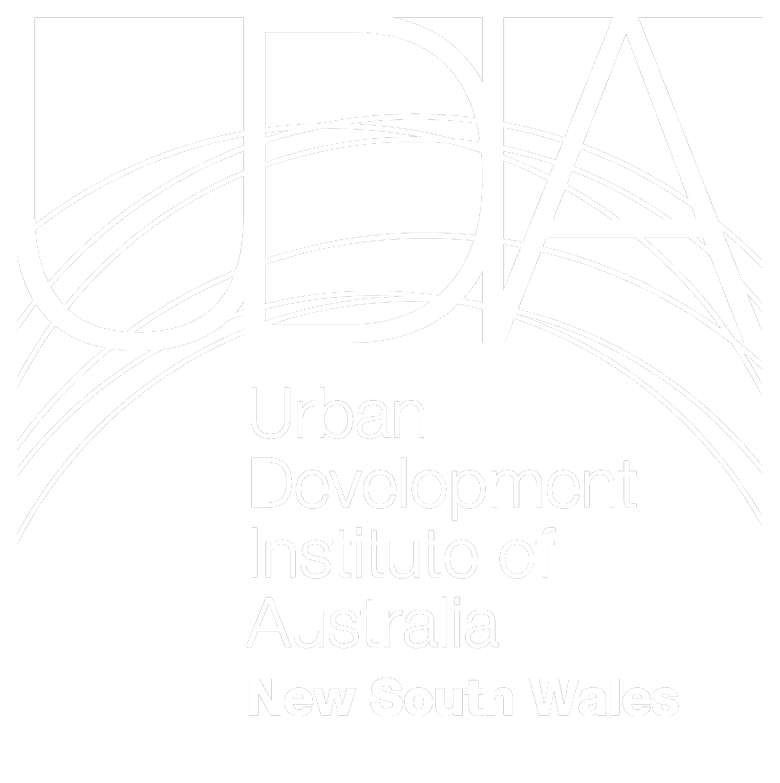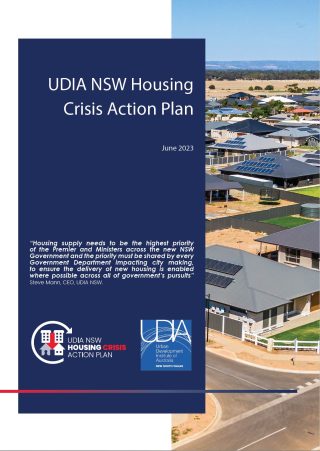UDIA’s policy report Housing Crisis Action Plan released today, shows why NSW is no longer in a housing crisis… it is now heading toward a housing emergency.
UDIA’s advocacy has been in overdrive over the past year when our Pre-Election Campaign Let’s Tackle the Housing Shortage called on political leaders to commit to deliver 315,000 houses which is NSW fair share of the Federal Government’s National Accord target to build 1 million well-located houses over the next five years.
Today that policy work has culminated in the UDIA Housing Crisis Action Plan which draws on first-hand data showing the obstacles holding up the delivery of much needed housing and outlines a broad range of actions that can deliver the urgently needed homes for the people of NSW.
“Housing supply needs to be the highest priority of the NSW Premier and the priority must be shared by every Minister and government department impacting city making, to ensure the delivery of hew housing is enabled across all of government’s pursuits,” said Steve Mann, CEO, UDIA NSW.
“We need key reforms such as speeding up housing approvals, unlocking infrastructure and addressing feasibility that can deliver affordable and market housing quickly, so that as immigration increases, we can meet the current local demand for homes and also accommodate the workers needed to get NSW open for business,” said Mr Mann.
UDIA’s Housing Crisis Action Plan which can be found at this link focuses on five key action areas and provides a series of practical, achievable, well researched recommendations that need immediate implementation if we are to reverse the course of the crisis and get on with building the homes and communities across our state.

Key Actions and Recommendations to support housing supply:
- Making the NSW Planning System Work – so it is simpler and more productive;
- Removing Prohibitive Development Controls – which stifle supply and feasibility;
- Coordinating Infrastructure Delivery – so that funding can target supply outcomes;
- Addressing feasibility, taxes and Levies – with a moratorium on increases in taxes, levies and charges which do not deliver equivalent productivity gains; and by
- Activating the regions by removing the constraints preventing supply.
UDIA NSW has done extensive modelling of the housing supply pipeline across the Sydney Megaregion in our Greenfield Land Supply Pipeline and Apartments Supply Pipeline 2022 reports, working with our members to study the constraints to supply. This puts UDIA in a unique position to provide modelling demonstrated in the graph above which shows the potential supply that could be unlocked with policy reforms, targeted funding that can boost housing supply over the next 5 years.
For the past 60 years, UDIA has used evidence-based research to help shape policies, precincts, and build the housing communities for the people of NSW during the good times and more recently when the NSW economy has struggled through the pandemic.
“There is no time to wait now given the lead times for industry to deliver and the challenging environment, UDIA stands ready to work together with Government to enable future NSW generations to realise the dream of home ownership.” said Mr Mann.
Potential Supply that could be unlocked with policy reforms:
- State Assessed Planning Pathway (SAPP) Projects: Potential supply – 35,000The SAPP pathway aims to rezone sites to accompany 70,000 lots by 2024. Submissions for these projects were made by industry in January 2023 and this is the first step the Minns Government should take to unlock housing in the medium term. The scale of these projects, greater than 1,000 homes in Sydney and 300 homes in regional markets, many will be apartments, provides a great opportunity to use FSR Bonusses to also deliver affordable housing at scale.
- Affordable Housing Bonuses: Potential supply – 10,500UDIA has collaborated with Atlas Economics to model pathways that can make a 30% bonus for Affordable Housing and modelling shows that 30% of the bonusses units would be viable for development.
- Resolve Biodiversity Constraints: Potential supply – 13,100UDIA NSW’s Greenfield Land Supply Pipeline Report October 2022 (GLSPR), includes a thorough survey of greenfield projects, across the Sydney Megaregion, to understand current constraints on delivery and forward pipeline projections, found that 13,100 greenfield homes that are projected for delivery between FY23-26 are held back by biodiversity approvals. Government should use the 5year review of the Biodiversity Conservation Act to resolve these barriers to housing supply.
- Amend the Apartment Design Guide: Potential supply – 8,500According to UDIAs Apartment Supply Pipeline Report – November 2022 for the Sydney Megaregion, 8,500 apartments in the supply pipeline directly reported the restrictiveness of the Apartment Design Guide, including Design Panels, and constrictive height and floor-space-ratios as being prohibitive to project completion or viability.
- New Complying Development Certificate (CDC) Pathways: Potential supply – 15,000Between 2015-2019, NSW produced a record 5-year rolling total of over 158,000 CDC approvals and DPE data shows that CDC’s, on average, are 3.9 times quicker than going through the Development Assessment process. The current 5-year rolling total for CDC approvals is 145,000. If government expanded CDC pathways into ‘missing middle’ products, this would comfortably help produce an additional 15,000 completions over the 5year period,
–Ends–
Media Enquiries:
Deanna Lane 0416 295 898 or dlane@udiansw.com.au

